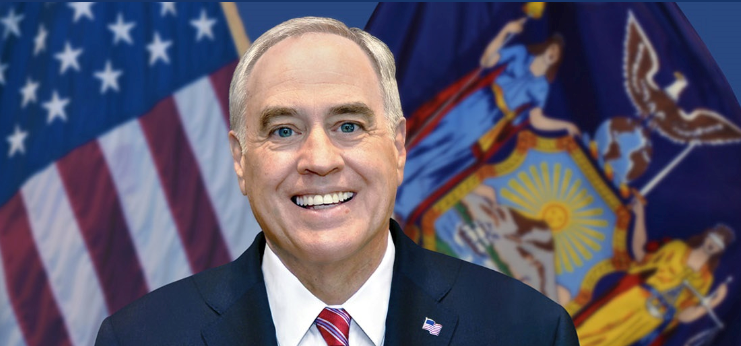New York City’s contract spending has grown significantly in recent years, rising to $24.3 billion in fiscal year (FY) 2023, an increase of nearly $7 billion from FY 2019.
This represents an outsized share of 41% of total citywide operating spending growth in this period, according to a report released by State Comptroller Thomas P. DiNapoli, a press release said.
“New York City’s spending on contracts for goods and services has risen faster than other spending and is consuming more of the city’s operating budget," DiNapoli said. “This rise requires the city to provide additional detail on what is fueling spending trends and publish results from performance evaluations of new and expanded programming. Greater transparency should lead to improved dialogue on whether vendors are providing cost-effective solutions without hurting service quality.”
New York City uses contracts for a variety of reasons, including the purchase of fleet and materials, the provision of social and educational services and specialized work. Total contract spending for goods and services represented nearly 22% of operating spending in FY 2023, compared to 16% in FY 2010.
Some of the growth in contract spending was for emergency services. In FY 2023, the city spent $1.6 billion on expense contracts for the COVID-19 pandemic and services for asylum seekers. Excluding these emergency expenses, contract spending still grew at an annual rate of 7% from FY 2019 to FY 2023, twice the rate of citywide spending and faster than inflation.
The city’s spending on criminal justice and indigent defense contracts in FY 2023 was more than five times what was spent in FY 2010, with annual spending rising 23% from FY 2019 to FY 2023.
Contract spending at the departments of Homeless Services, Aging, Small Business Services, and Youth and Community Development all exceed 80% of total spending at those agencies.
For some city agencies, spending growth corresponded with the rollout of new initiatives and a higher demand for services. The largest dollar growth in contract spending from FY 2019 to FY 2023 was at the Department of Education (DOE), partially fueled by pandemic relief funded additions to programming. DOE accounted for almost half of the city’s contract spending in FY 2023 when excluding extraordinary expenses.
Department of Education
Contract costs at the DOE have risen significantly since FY 2010, from nearly $3.9 billion to over $10.5 billion in FY 2023, increasing by 170%, and accounting for more than half of the total increase in the agency’s operating costs. These costs grew as substantial programming was added, new approaches were taken on custodial and transportation services, and charter school enrollment and spending on federally mandated special education services, known as Carter Cases, rose.
Between FY 2010 and FY 2014, growth was $718 million, driven mostly by the introduction and expansion of charter schools, and accounting for 45.5% of the total increase in DOE operating costs over that period.
Contract spending rose by more than $3.2 billion from FY 2019 to FY 2023, fueled by spending on charter schools ($801 million) and Carter Cases ($486 million) costs. These expansions were initially supported by federal pandemic relief and state funding, and each accounted for nearly $520 million of the increase.
DOE contract costs accelerated between FY 2014 and FY 2019, rising by nearly $2.7 billion, led by about $1 billion from charter school costs and $662 million added for school facilities as the city restructured its contracts with janitorial staff. The city also introduced Universal Pre-Kindergarten (UPK) for 4-year-olds, which added $353 million in contract costs by 2019.
Contract spending on UPK grew even as UPK enrollment dropped by more than 11,000 (16.1%). Enrollment in the 3-K program grew from just 3,300 children in FY 2019 to nearly 40,000 in FY 2023.
Department of Homeless Services
The DHS spent $2.4 billion on contracted services in FY 2023, excluding COVID and asylum seeker-related costs, mostly to provide shelter for unhoused individuals and families, as well as drop-in and outreach services to street homeless individuals. This reflects an increase of $457.6 million since FY 2019 and $1.6 billion since FY 2010.
Homeless family and individual services account for the largest share of contract costs at DHS in FY 2023 (95%, or $2.3 billion combined), primarily for shelter and intake programs. The growth in shelter contracts was driven by the shelter model budget reform, initiated in 2016, which included efforts to make repairs and enhance social services and security at shelters, while also standardizing rates for services.
DiNapoli recommended the city consider publishing greater detail on how providers are paid for the service delivered as well as program evaluations for new and expanded work. These transparency measures can provide the public with a better understanding of the rationale for the city’s choices and encourage dialogue on the most cost-effective means of delivering quality services.
Highlighting prior DiNapoli audits, the report notes that growth in contract spending also necessitates that city agencies are sufficiently staffed and trained to negotiate contracts, process payments in a timely fashion, and provide programmatic oversight to ensure service quality and contract compliance.




